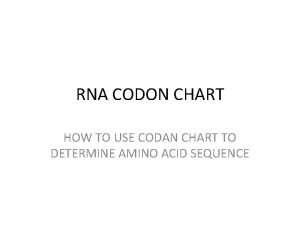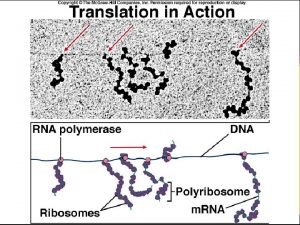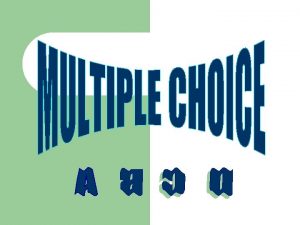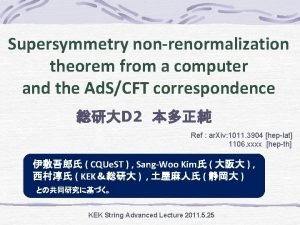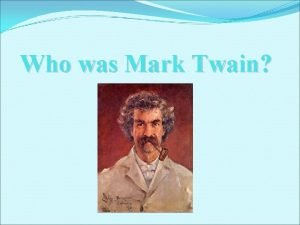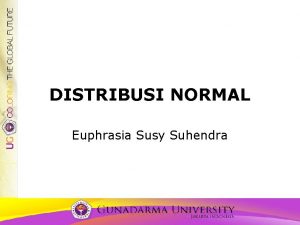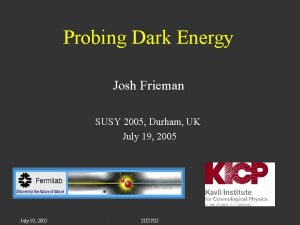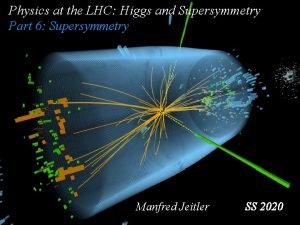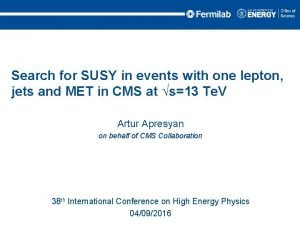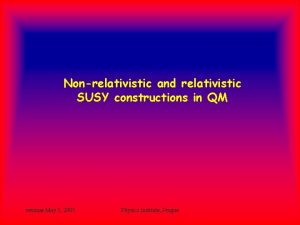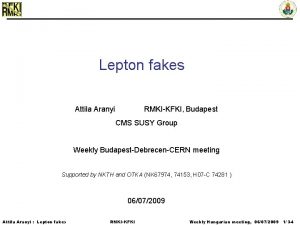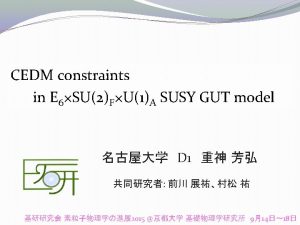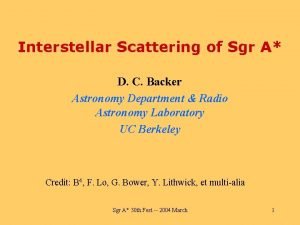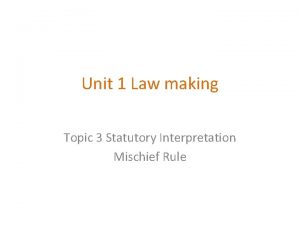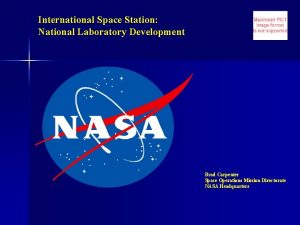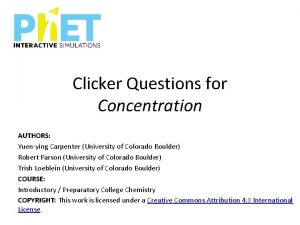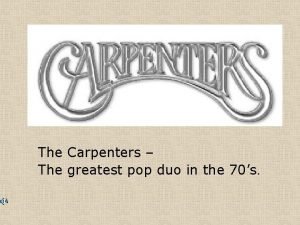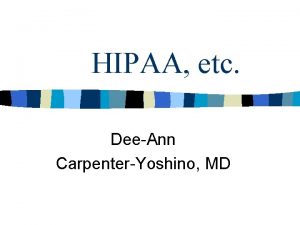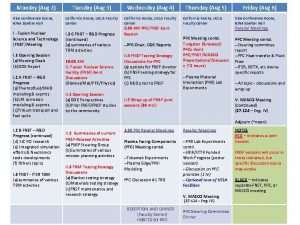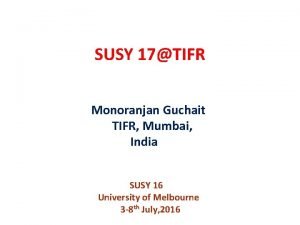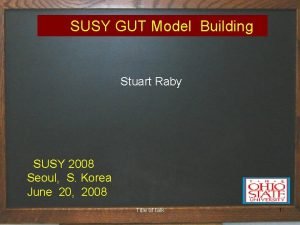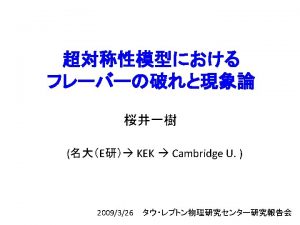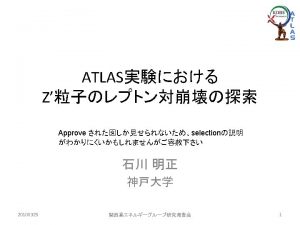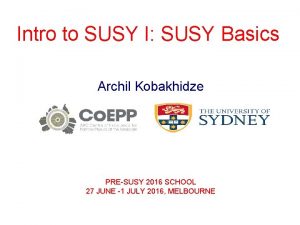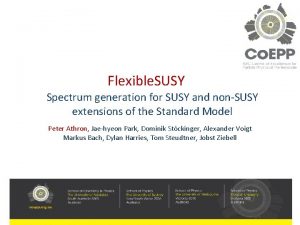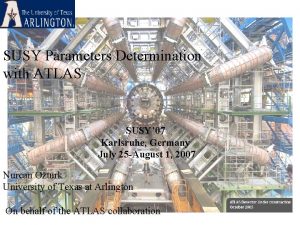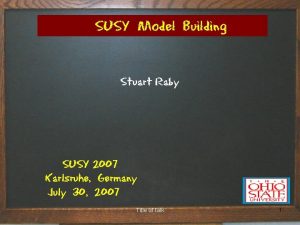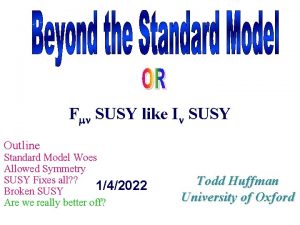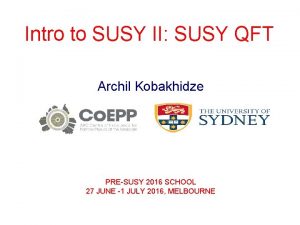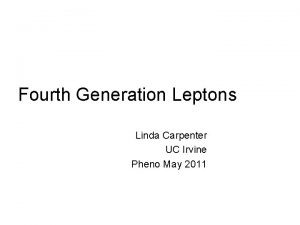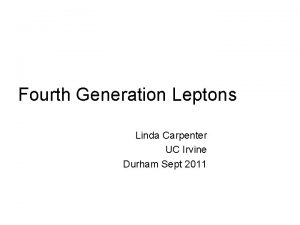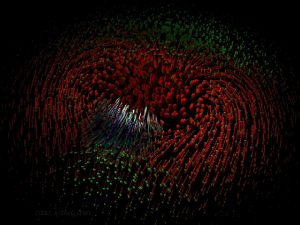AntiSplit SUSY Linda Carpenter Aug 2011 There are





































- Slides: 37

Anti-Split SUSY Linda Carpenter Aug 2011

There are compelling theoretical reasons to look beyond Minimal SUSY spectra In minimal spectra we look for moderately heavy states charged under QCD and light electroweak -states Models that done have this phenomenology are theoretically plausible and phenomenologicaly interesting

Standard MSSM spectrum* *Minimal Gauge Mediation


No good reason why we should be beholden to the anarchy of 105 parameters of the MSSM or the rigidity and tuning of minimal models.

Some Alternative Spectra Split SUSY-scalars very heavy, gauginos light and long lived Higgsino World-only Higgs sector is light Super. Soft-Scalars sqrt of a loop factor below gaugino masses General Gauge Mediation-light Gravitino, multiple mass parameters

Anti-Split SUSY Gauginos massive enough to be inaccessible to colliders & Scalar mass spectrum compressed. Can build quick (if dirty) models in a general kind of Gauge Mediation which are simple and retain flavor blindness and the possibility of light gravitinos Particle decay chains are very different and interesting Some notion of naturalness in the Higgs sector is preserved

Minimal Gauge Mediation messenger fields communicate SUSY breaking to the MSSM

Gaugino and scalar masses are proportional to a single mass parameter gaugino masses are given by Scalar masses are given by

General Gauge Mediation allows 6 mass parameters 3 for gauginos and three or scalars

One may build GGM models with weakly coupled renormalizable superpotentials and multiple SUSY breaking spurions MSMM masses depend on multiple mass parameters, for example two in a two parameter model Leads to masses

Consider a three parameter model The gluino mass is given by three parameters and may be canceled Scalar masses however depend on the sum of squares of mass parameters and may not

We can generate models in GGM easily that break the dependency of gauginos and scalars. Two simple ways are: Modified Super. Soft Normal GM with the addition of negative scalar supertraces

Dirac Gauginos Require the existence of an adjoint field for each SM gauge group as well as a U(1)’ gauge field The U(1)’ has D-term vev, when inserted one gets an operator which is a Dirac gaugino mass


These masses lead to ‘supersoft’ scalar masses Which are less than the gaugino masses by the square root of a loop factor. Then the ratio of gaugino to scalar masses is at least

Notice as the adjoint mass d goes to 0, the scalars become independent of the gaugino masses. If we give negative mass contributions to the real adjoint scalar mass, normally twice the gaugino mass, then we can have arbitrarily heavy gauginos relative to scalars

R symmetric scalar masses Recall the supertrace Messenger masses may have holomorphic and nonholomorphic components. Q masses have diagonal and off diagonal components, diagonal are both supersymmetric and nonsupersymmetric.

This leads to log divergent diagrams contributing to scalar mass Resultant scalar masses are These masses are R symmetric and do not contribute to gaugino masses.

Scalar masses are UV sensitive, because of Log divergence Scalar masses proportional to opposite sign of supertrace. This means positive scalar mass squareds require negative messenger supertraces. Most of the time one gets large mass contributions to scalars which are negative.

Gauge mediated gaugino masses Gaugino masses arise at loop level by integrating out messenger fields. These messengers also couple to the adjoints. These must be charged under the U(1)’, as well as the SM gauge groups. If the messengers have a non-zero D term then a diagram exists which produced a one loop gaugino mass proportional to the D-term


Plus other gauge mediated Scalar Masses

Possible Mass Spectrum

Even simpler Model, if one doesn’t care about cancelations in scalar masses, just make heavy majorana neutrinos through normal gauge mediation And add Log divergent Scalar masses to cancel the large two loop GM scalar masses

Decays to Gravitinos NLSPs eventualy decay their SM partners plus a gravitino for Higgsino LSPs we have While for Sfermions

Phenomenology Low energy spectra contain decay chains with many particles Scalars are under 1 Te. V, the mu term is small so a light Higgsino survives in the low energy; two light neutralinos and one light chargino.

SPECTRA

Stau NLSP

U, D squark decay chain

Stop Decay Chain

Higgsino Pair Production

LH Slepton Decay Chain

Higgsino NLSP Chargino and Neutralino are quite degenerate. Possibility of lightest neutralino decay to h+Gravitino

Sneutrino NLSP

General Features of Anti-Split Spectra -Generically light Higgsinos means degenerate Neutralino and Chargino -Because Bino and Wino States are heavy one gets Low Energy Gauge Mediation without hard photons -Non-standard decays chains for sparticles containing missing energy and many particles -Decay of Pair produced states contain multiple Higgs’s or staus

Future Directions -It is always possible to build nicer models -Nonstandard decay chains change SUSY exclusion bounds -There are many possible search scenarios to analyze
 Mikael ferm
Mikael ferm Pangalan ng palimbagan ng el filibusterismo
Pangalan ng palimbagan ng el filibusterismo Techno root word
Techno root word Aug q
Aug q Aug methionine start codon
Aug methionine start codon Aug comm device
Aug comm device Mrna amino acid chart
Mrna amino acid chart Initiell
Initiell Who do lennie and george agree to let live on their farm
Who do lennie and george agree to let live on their farm Susy qm
Susy qm Susy clemens
Susy clemens Pt gs mengklaim rata rata berat buah mangga
Pt gs mengklaim rata rata berat buah mangga Susy dala
Susy dala Susy shear
Susy shear Susy_clemens
Susy_clemens Supersymmetry primer
Supersymmetry primer Susy dala
Susy dala Susy klein
Susy klein Susy
Susy Fake?
Fake? Susy isn't a normal maid
Susy isn't a normal maid Susy model
Susy model Susy backer
Susy backer Braden castro
Braden castro Ward carpenter md
Ward carpenter md Corkery v carpenter mischief rule
Corkery v carpenter mischief rule Catherine carpenter southwestern
Catherine carpenter southwestern Classification of tools used to assemble wood
Classification of tools used to assemble wood Brad carpenter nasa
Brad carpenter nasa Yuen ying carpenter
Yuen ying carpenter Galapagos carpenter bee
Galapagos carpenter bee The carpenters awards
The carpenters awards Hypopalsia
Hypopalsia The farm koronadal
The farm koronadal Corkery v carpenter 1951
Corkery v carpenter 1951 David carpenter serial killer
David carpenter serial killer Geppetto was a carpenter
Geppetto was a carpenter Dr dee-ann carpenter
Dr dee-ann carpenter






